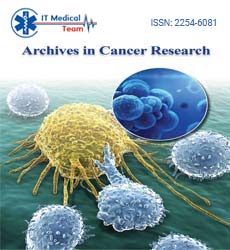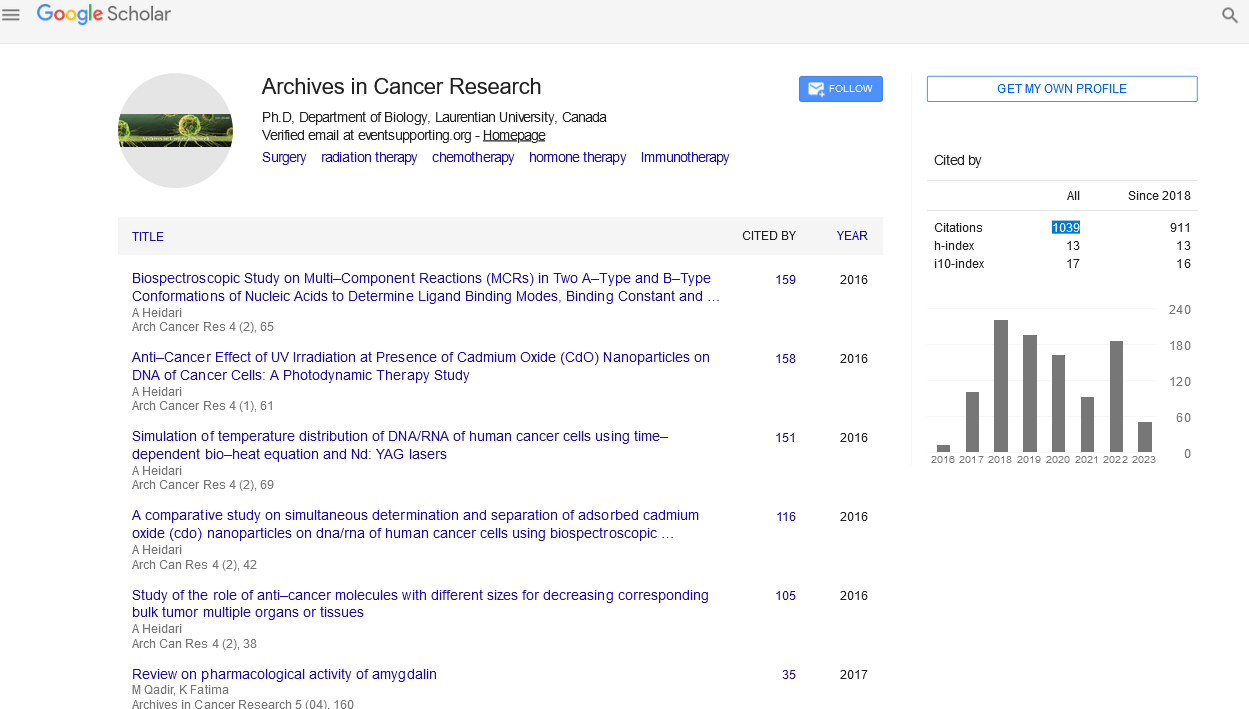Perspective - (2024) Volume 12, Issue 4
Understanding Neoplasms: A Comprehensive Overview
Abiodun Arai*
Department of Cancer Biology, University of Toronto, Canada
*Correspondence:
Abiodun Arai, Department of Cancer Biology, University of Toronto,
Canada,
Email:
Received: 19-Jul-2024, Manuscript No. IPACR-24-15002;
Editor assigned: 22-Jul-2024, Pre QC No. IPACR-24-15002 (PQ);
Reviewed: 05-Aug-2024, QC No. IPACR-24-15002;
Revised: 13-Aug-2024, Manuscript No. IPACR-24-15002 (R);
Published:
20-Aug-2024
Introduction
Neoplasms, commonly known as tumors, represent an
abnormal growth of tissue resulting from uncontrolled,
progressive multiplication of cells. These growths can be benign
(non-cancerous) or malignant (cancerous), affecting various
tissues and organs in the body. The term "neoplasm" comes
from the Greek words "neo" (new) and "plasma" (formation),
reflecting the abnormal proliferation of cells. This article delves
into the types, causes, symptoms, diagnosis, treatment, and
ongoing research related to neoplasms, providing an in-depth
understanding of this complex medical condition.
Description
Types of Neoplasms
Neoplasms are broadly categorized into benign and malignant
types, each with distinct characteristics and clinical implications.
Benign neoplasms: Benign neoplasms are non-cancerous
growths that typically grow slowly and do not spread to other
parts of the body. While they can cause local problems due to
their size or location, they generally have a favorable prognosis.
Adenomas: These neoplasms originate in glandular tissues.
Examples include pituitary adenomas, thyroid adenomas, and
adrenal adenomas.
Fibromas: Derived from fibrous or connective tissue, fibromas
can occur in any organ but are commonly found in the uterus
(uterine fibroids).
Lipomas: These are composed of fat cells and are usually
found just under the skin. Lipomas are generally painless and
slow-growing.
Meningiomas: These tumors arise from the meninges, the
protective membranes covering the brain and spinal cord. Most
meningiomas are benign but can cause significant neurological
symptoms due to their location.
Malignant neoplasms: Malignant neoplasms, or cancers, are
characterized by uncontrolled growth, the ability to invade
nearby tissues, and metastasis (spread to distant sites). They are
more aggressive and pose a significant threat to health and life.
Carcinomas: Originating from epithelial cells, carcinomas are
the most common type of cancer. They include breast cancer,
lung cancer, and colorectal cancer.
Sarcomas: These cancers arise from connective tissues such
as bone, muscle, and fat. Examples include osteosarcoma (bone
cancer) and liposarcoma (fat tissue cancer).
Leukemias: Cancers of the blood and bone marrow, leukemias
are characterized by the excessive production of abnormal white
blood cells.
Lymphomas: These cancers originate in the lymphatic system,
which is part of the immune system. They include Hodgkin
lymphoma and non-Hodgkin lymphoma.
Gliomas: A type of brain cancer, gliomas arise from glial cells
that support nerve cells. Glioblastoma is a particularly aggressive
form of glioma.
Causes and risk factors
The exact cause of neoplasms is often multifactorial, involving
a combination of genetic, environmental, and lifestyle factors.
Symptoms: The symptoms of neoplasms vary widely depending
on their type, location, and size. Common symptoms include:
Pain: Neoplasms can cause pain by pressing on nerves,
organs, or bones.
Unexplained weight loss: Significant and unexplained weight
loss can be an early sign of cancer.
Fatigue: Persistent fatigue that doesn't improve with rest may
indicate an underlying neoplasm.
Changes in skin: Unexplained changes in skin color, texture, or
the appearance of new moles can be signs of skin cancer.
Persistent cough or hoarseness: Chronic cough or changes in
voice can be symptoms of lung or throat cancer.
Unusual bleeding or discharge: Abnormal bleeding, such as
blood in the stool, urine, or unusual vaginal bleeding, can
indicate cancers of the digestive or reproductive systems.
Lumps or masses: The presence of lumps or masses in the
breast, testicles, or other areas can be indicative of neoplasms.
Diagnosis: Diagnosing neoplasms involves a combination of
medical history, physical examination, imaging studies,
laboratory tests, and biopsy.
Medical history and physical examination: A thorough
medical history and physical examination can provide clues
about the presence and nature of a neoplasm.
Imaging studies: Imaging techniques such as X-rays,
Computed Tomography (CT) scans, Magnetic Resonance Imaging
(MRI), Positron Emission Tomography (PET) scans, and
ultrasound are used to visualize neoplasms and assess their size,
location, and spread.
Laboratory tests: Blood tests, urine tests, and other
laboratory analyses can detect markers indicative of neoplasms.
Biopsy: A biopsy involves removing a sample of tissue from
the neoplasm for microscopic examination. This is the definitive
method for diagnosing neoplasms and determining their type
and grade.
Treatment: Treatment of neoplasms depends on their type,
location, stage, and the patient's overall health. The main
treatment modalities include surgery, radiation therapy,
chemotherapy, targeted therapy, and immunotherapy.
Surgery
Surgery aims to remove the neoplasm and is often the first
line of treatment for many benign and malignant tumors. The
extent of surgery depends on the tumor's size, location, and
whether it has spread to other parts of the body.
Curative surgery: This is performed with the intent to
completely remove the tumor and achieve a cure.
Palliative surgery: When curative surgery is not possible,
palliative surgery may be performed to relieve symptoms and
improve quality of life.
Debulking surgery: In cases where complete removal is not
possible, debulking surgery reduces the size of the tumor to
make other treatments more effective.
Radiation therapy
Radiation therapy uses high-energy beams to kill cancer cells
or shrink tumors. It can be used as a primary treatment or in
combination with surgery and chemotherapy.
External Beam Radiation Therapy (EBRT): The most common
form, delivering radiation from outside the body.
Brachytherapy: Involves placing radioactive sources directly
into or near the tumor.
Stereotactic radiosurgery: A precise form of radiation therapy
that targets small tumors with high doses of radiation.
Chemotherapy: Chemotherapy uses drugs to kill rapidly
dividing cells, including cancer cells. It can be used alone or in
combination with other treatments.
Systemic chemotherapy: Drugs are administered orally or
intravenously, affecting the entire body.
Regional chemotherapy: Drugs are delivered directly to the
tumor site, minimizing systemic side effects.
Immunotherapy: Immunotherapy harnesses the body's
immune system to fight cancer. It includes treatments such as
immune checkpoint inhibitors, CAR-T cell therapy, and cancer
vaccines.
Checkpoint Inhibitors: These drugs block proteins that
prevent the immune system from attacking cancer cells.
CAR-T cell therapy: Involves modifying a patient's T cells to
recognize and attack cancer cells.
Cancer vaccines: These vaccines stimulate the immune system
to recognize and attack specific cancer-related antigens.
Research and future directions
Ongoing research is essential for improving the understanding
and treatment of neoplasms. Several areas of research hold
promise for future advances.
Genomics and molecular biology: Advances in genomics and
molecular biology are providing insights into the genetic and
molecular underpinnings of neoplasms, leading to the development
of targeted therapies.
Precision medicine: Precision medicine aims to tailor treatment
to the individual characteristics of each patient's tumor, improving
outcomes and minimizing side effects.
Immunotherapy: Research into new immunotherapeutic
approaches is ongoing, with the potential to revolutionize cancer
treatment.
Artificial intelligence and machine learning: AI and machine
learning technologies are being applied to analyze large datasets,
improve diagnostic accuracy, and predict treatment responses.
Conclusion
Neoplasms represent a diverse and complex group of diseases
with varying prognoses and treatment options. Advances in
understanding the genetic and molecular basis of neoplasms,
along with improvements in diagnostic and therapeutic
approaches, are continually improving the outlook for patients.
Ongoing research and clinical trials are essential for furthering
the fight against neoplasms, offering hope for better outcomes
and improved quality of life for patients worldwide. As the field
progresses, collaboration among researchers, clinicians, and
patients will be crucial in driving forward the battle against this
multifaceted disease.
Citation: Arai A (2024) Understanding Neoplasms: A Comprehensive Overview. Archives Can Res Vol:12 No:4





